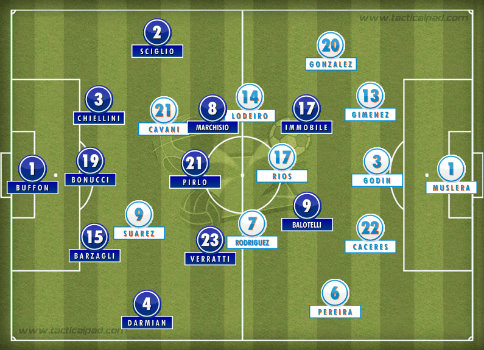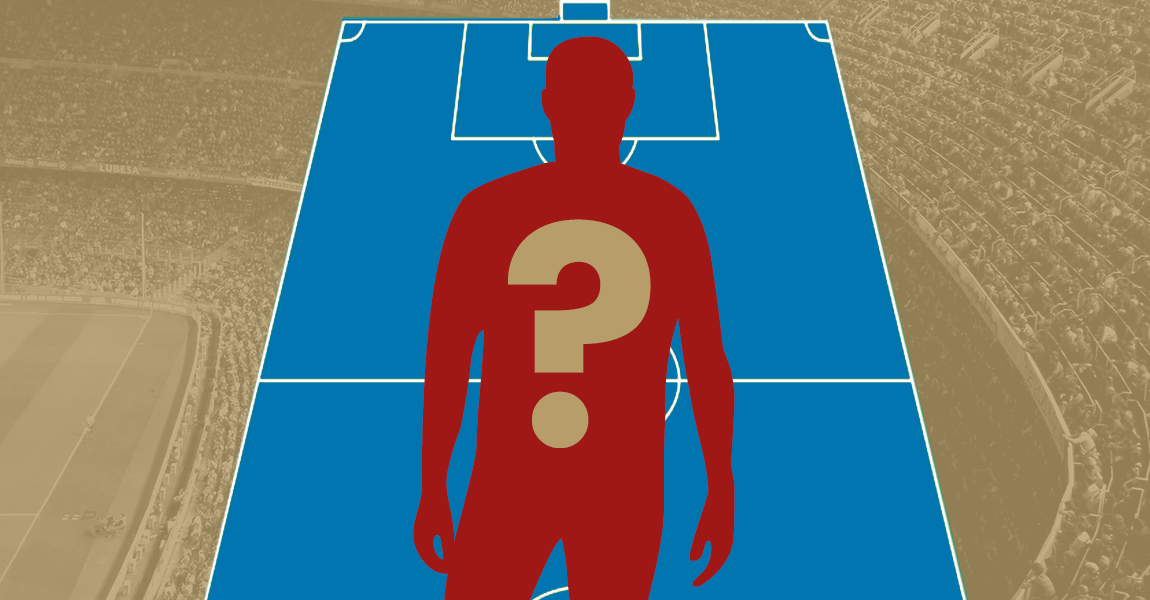The Azzurri were expected to be comfortably through already following an opening-match win over England, but Costa Rica ended hopes of a quick qualification for Cesare Prandelli’s team. Uruguay were also left stunned by the Group D’s surprise team when they lost 3-1 to the Costa Ricans in their first group match. However, the return of Liverpool striker Luis Suarez to the starting XI against England proved to be the catalyst for a 2-1 victory. Therefore, the setting was simple. Uruguay needed a win, Italy needed to avoid defeat to progress to the knockout rounds.
Formation & Line-Ups

Italy (3-4-1-2): Buffon, Barzagli, Bonucci, Chiellini, Darmian, Verratti (Motta 75’), Pirlo, Marchisio, De Sciglio, Balotelli (Parolo 45’), Immobile (Cassano 71’)
Uruguay (5-3-1-1): Muslera, Álvaro Pereira (Stuani 63’), Giménez, Godín, Cáceres, González, Arévalo Ríos, Lodeiro (Maxi Pereira 45’), Rodríguez (Ramírez 78’), Cavani, Suárez
Goals: Godín (81’)
Basic setup
Both Prandelli and Oscar Tabárez changed the formation. As expected, the Italian Coach reverted to a 3-5-2 formation that has served him so well in the past, with Ciro Immobile partnering Mario Balotelli and Leonardo Bonucci entering the defensive line. It was a cautious system with two wing-backs in deep positions, while Claudio Marchisio played a No. 10. Antonio Candreva, was removed from the starting XI.
RELATED ARTICLES
The Uruguay line-up involved in the victory over England remained unchanged. They were much more as expected, with Suarez and Edinson Cavani once again tasked with creating much of their attacking threat. However, Uruguay mostly played in a ‘new’ 5-3-1-1, that often became a 3-3-3-1 with the wing-backs playing more actively on offense.The expectation was that Álvaro González would be deployed as an attacking midfielder. But in fact, he was the counterpart to left wing-back Álvaro Pereira. Martin Cáceres moved back and played alongside the centre-backs Diego Godín and José María Giménez.
Man-marking all over the place
With the 3-5-2 resurgent at the World Cup, you can expect a wave of simple interpretations. The clash between Italy and Uruguay was a game where the sides effectively man-marked one another. Edinson Cavani was on Andrea Pirlo, Ciro Immobile on Arévalo Rios, Luis Suárez on Leonardo Bonucci, Mario Balotelli on Godín and so on. In fact, both systems neutralised each other. No-one could find any room in midfield. In a game of few clear chances, however, Italy had been relatively comfortable throughout. In addition, there were many duels and fouls in midfield. The first half saw twice as many fouls as shots. Uruguay could not put enough pressure on the back three in the first half. La Celeste needed obviously some magic from Suarez, but he was barely involved. Uruguayan frustration was summed up toward the end of the first half when Martin Cáceres attempted a 70-yard chip over Buffon.
Uruguay’s approach
La Celeste played an asymmetric formation with Cristian Rodríguez wide out, while Nicolás Lodeiro was behind Cavani. Both Suárez and Cavani pressed very aggressively. The Liverpool man moved usually between Pirlo and Bonucci. Rodríguez and Lodeiro contributed to the second line of press as part of a three. Their initial approach seemed to be similar to the one they applied to winning effect against England, with Cavani this time told to focus his intentions on Andrea Pirlo. That limited the regista’seffectiveness to a certain extent.
Sometimes Pirlo and Marco Verratti swapped positions so Pirlo could escape from pressure. Instead of their usual ball circulation, Italy were isolated in their own half. The connections from Balotelli and Immobile to the deeper centre were weak and pulled the formation far apart. Italy dominated possession throughout but only had two chances to show for it. Uruguay spent long periods of the first half chasing the ball.
Revert to a trusty system
Prandelli set out his side with a clear defensive mind-set with well positioned midfielders preventing the attackers from having a contribution on the game. The revival of the trusty 3-5-2 system enabled the Azzurri to dominant centre spaces. Matteo Darmian played passively on the right and cared primarily about supporting the defence and stopping Uruguay’s left winger Rodríguez. However, he left gaps as he moved forward in the early stage of the match. In fact, the wing-backs were asked to provide width and to care primarily about a simple ball circulation. The focus in the build-up play was on the centre. Pirlo and Verratti saw plenty of the ball, but only a few of their passes reached the final third successfully. Italy lacked a link man, while Marchisio was largely ignored by his teammates. Immobile and Balotelli, two typical No. 9s, moved high up the pitch, but they did not use vertical runs to create connections to the midfield.
Adjustments in the second half
At half-time, both sides made changes, with Maxi Pereira replacing Lodeiro and Balotelli being withdrawn for Parma winger Marco Parolo following a first-half yellow card. The change seemed to improve Uruguay, with Pereira giving them a bit more width on the right. They looked to be increasingly dangerous on the ball. The South Americans gradually started to press and had their first real chance in the 58th minute when Rodriguez played a sharp one-two with Suarez. Afterwards, the Italians were reduced to ten men when Marchisio was sent off for a foul on Arévalo Rios.Tabarez put another forward on, signalling his team’s intent to now go for the win. Italy converted to a 5-3-1, with Immobile dropping deeper and no-one occupying Uruguay’s defenders. After 81 minutes la Celeste grabbed the goal they needed when Diego Godin broke through on a set piece.
Key Player of the Match
Though Uruguay defeated the Azzurri, Marco Verratti displayed a great performance. The PSG midfielder combined excellent passing play with tricky dribbling and intelligent movement. Verratti is more than Pirlo’s sidekick and he will be the next regista in the Italian squad. Against Uruguay, he had success with 95 % of his passes and had five successful dribbling. The 21-year-old made three tackles and was fouled three times. (According to WhoScored)
Where does this leave them?
Italy won their first game against England, but then lost to Group D winners Costa Rica last week and were eliminated following their defeat to Uruguay. Coach Cesare Prandelli resigned after his team failed to qualify for the knockout stage of the World Cup. The new man in charge will rebuild a squad and can use the potential of some quite talented players.
Uruguay finish second to set up a round of 16 clash with Colombia. However, Luis Suárez’ bite on Italy defender Giorgio Chiellini was not punished by Mexican referee Marco Rodriguez. Though he could still be subject to punishment from FIFA’s Disciplinary Committee.
This article was written by Constantin Eckner. Follow him on Twitter @cc_eckner
Read all our World Cup 2014 content here
- Tactical Philosophy: Thomas Tuchel - July 24, 2015
- Borussia Dortmund: What went wrong? - June 11, 2015
- Why Kevin Kampl has been so important for Dortmund’s revival - March 4, 2015

























































